Nitric oxide mediates the indole acetic acid induction activation of a mitogen-activated protein kinase cascade involved in adventitious root development
- PMID: 15122018
- PMCID: PMC429373
- DOI: 10.1104/pp.103.038554
Nitric oxide mediates the indole acetic acid induction activation of a mitogen-activated protein kinase cascade involved in adventitious root development
Abstract
Recently, it was demonstrated that nitric oxide (NO) and cGMP are involved in the auxin response during the adventitious rooting process in cucumber (Cucumis sativus; Pagnussat et al., 2002, 2003). However, not much is known about the complex molecular network operating during the cell proliferation and morphogenesis triggered by auxins and NO in that process. Anatomical studies showed that formation of adventitious root primordia was clearly detected in indole acetic acid (IAA)- and NO-treated cucumber explants, while neither cell proliferation nor differentiation into root primordia could be observed in control explants 3 d after primary root was removed. In order to go further with signal transduction mechanisms that operate during IAA- and NO-induced adventitious root formation, experiments were designed to test the involvement of a mitogen-activated protein kinase (MAPK) cascade in that process. Cucumber explants were treated with the NO-donor sodium nitroprusside (SNP) or with SNP plus the specific NO-scavenger cPTIO. Protein extracts from those explants were assayed for protein kinase (PK) activity by using myelin basic protein (MBP) as substrate in both in vitro and in-gel assays. The activation of a PK of approximately 48 kD could be detected 1 d after NO treatment with a maximal activation after 3 d of treatment. In control explants, a PK activity was detected only after 4 d of treatment. The MBP-kinase activity was also detected in extracts from IAA-treated explants, while no signal was observed in IAA + cPTIO treatments. The PK activity could be inhibited by the cell-permeable MAPK kinase inhibitor PD098059, suggesting that the NO-dependent MBP-kinase activity is a MAPK. Furthermore, when PD098059 was administered to explants treated with SNP or IAA, it produced a delay in root emergence and a dose-dependent reduction in root number. Altogether, our results suggest that a MAPK signaling cascade is activated during the adventitious rooting process induced by IAA in a NO-mediated but cGMP-independent pathway. The activation of MAPKs is discussed in relation to the cell responses modulating mitotic process.
Figures
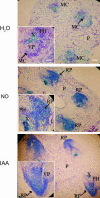
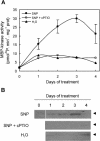
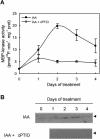

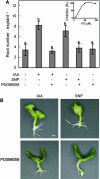

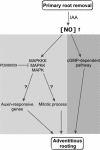
References
-
- Alessi DR, Cuenda A, Cohen P, Dudley DT, Saltiel AR (1995) PD098059 is a specific inhibitor of the activation of mitogen-activated protein kinase kinase in vitro and in vivo. J Biol Chem 270: 27489–27494 - PubMed
-
- Beligni MV, Lamattina L (2000) Nitric oxide induces seed germination and de-etiolation, and inhibits hypocotyls elongation, three light-inducible responses in plants. Planta 210: 215–221 - PubMed
-
- Beligni MV, Lamattina L (2001) Nitric oxide: a non-traditional regulator of plant growth. Trends Plant Sci 6: 508–509 - PubMed
-
- Bradford MM (1976) A rapid and sensitive method for the quantitation of microgram quantities of protein utilizing the principle of protein-dye binding. Anal Biochem 72: 248–254 - PubMed
Publication types
MeSH terms
Substances
LinkOut - more resources
Full Text Sources
Miscellaneous

